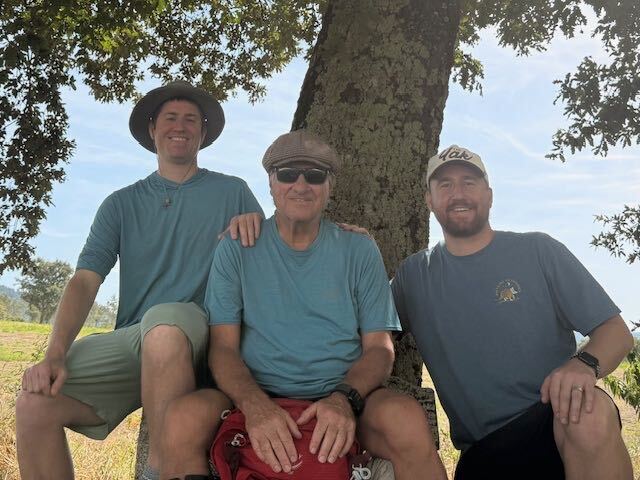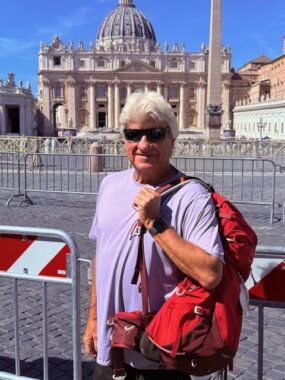70-year-old with ALS makes pilgrimage to raise funds, awareness
Kermit Peterson's trek follows ancient road to Rome

Kermit Peterson with sons Tony, left, and Mickey, right, on Italy's Via Francigena. (Courtesy of Kermit Peterson)
On Sept. 1, Kermit Peterson — 70 years old, wearing a brace on his leg, and living with amyotrophic lateral sclerosis (ALS) — embarked on a mission. His goal was to walk part of the Via Francigena, a centuries-old route that leads to Rome, and raise money for ALS research.
Over the course of nearly three weeks, Peterson encountered steep climbs, rugged trails, and a weakening leg. There were moments when he wondered if he would finish.
“The walk was much harder than I thought it would be,” says Peterson, who was diagnosed with sporadic ALS in 2023. “One day I had to walk at least two miles uphill. My right leg was so tired, and there was no place to sit down. I was literally hanging onto signs, walking from pole to pole. And there is no one coming to help you. You can sit on the side of the road and cry, and still, no one.”
With his son Tony, 38, Peterson set out on a journey he called Step by Step for ALS. Peterson’s wife, Robin, and son, Mickey, 31, sometimes joined them along the way.
Walking toward a cure
Starting in the Middle Ages, the nearly 2,000-mile-long Via Francigena served as a corridor for soldiers, traders, and pilgrims traveling from Canterbury, England, through France and Switzerland, to Rome.
Peterson walked an Italian portion of the ancient route, from Siena in Tuscany to Vatican City in Rome. In addition to raising funds for ALS research at Duke University, he hoped to raise awareness of ALS and inspire others living with the progressive neurodegenerative disorder.
Peterson had walked the historic Camino de Santiago through France and Spain. Next on his list was the Via Francigena. But those plans nearly changed after his diagnosis in July 2023 —six months after he noticed foot drop (a condition that makes lifting the front of the foot while walking difficult).
“When ALS happened, I thought I would never be able to do this,” says Peterson, who lives in Denver and is active with ALS United Rocky Mountain.
Peterson has worsening weakness and atrophy in his right leg, which reduces his push-off strength, and occasional muscle twitching that requires resting. He recently began taking an experimental oral therapy designed to reduce inflammation and protect nerve cells from damage.
According to his doctors, he’s an ALS outlier, with a slower-progressing form of the disease. So he decided to stick to his plan.
He prepared by taking long walks with the family’s two dogs. Still, he worried that his right leg would tire too quickly.
Trekking toward the Vatican
Each day brought long, laborious walks — about 6 miles on average — through groves of olive, fig, and walnut trees, traversing forest trails and paved highways.
Peterson wrote on social media about the trek’s demands, including a grueling detour that forced him and Tony to hike three to four steep, rocky miles straight uphill.
“Then we needed to walk on a road that can barely fit two cars,” he said in a Sept. 4 Facebook post. “I was not walking one mile per hour. My legs were getting weaker and more unsteady.”

Kermit Peterson takes a photo at the Vatican. (Courtesy of Kermit Peterson)
On Sept. 6, he shared that he had “recovered nicely from the other day with no muscle twitches at all, just a tired right leg.”
Sept. 7 was a particularly poignant day. Mickey joined the walk, and in his backpack were the ashes of his brother Sam, who died in 2019 at age 30.
“I walked in Italy on the Via Francigena with all my sons,” says Peterson. “Now, that was extraordinary.”
On Sept. 19, Peterson made it to St. Peter’s Square in Vatican City.
“I was so happy to complete this journey,” he wrote. “Walking pilgrimages is like your life, you have so many highs then setbacks as well.”
When he returned, he needed a few days to recoup his energy, but now says he feels “really strong” mentally and physically — about the same as before the trip.
In November, he will undergo testing at the Mayo Clinic in Scottsdale, Arizona, to check whether the trip had any impact on his strength and breathing.
Richard Bedlack, MD, PhD, a neurology professor at Duke University School of Medicine, followed Peterson’s expedition daily on Instagram. All donations raised by Peterson go toward Bedlack’s research to find better treatments and a cure for ALS.
“Kermit took on an incredibly difficult physical and mental challenge with this walk,” Bedlack wrote in an email sent to ALS News Today. “His daily videos showed not only the problems ALS has caused for his walking, but also the distance, the hills, the uneven ground, and the weather that were all thrown at him. But persevering and completing this quest, he showed the world that ALS does not define him. Even though it has taken some of his motor neurons, the more important parts of him are stronger than ever: his charisma, his sense of humor, his courage, and his advocacy for others. He is beating ALS spiritually, and in this way is inspiring many of us to keep fighting in our own ways.”
Beyond raising funds for research, Peterson wanted to remind others with ALS that life’s beauty persists, even in the face of enormous challenges.
“People can do more than they think they can,” he said. “Whether you do things through art or music or reading, or, in my case, walking, there’s a way to have a life, and bring positivity to your life, when you have ALS.”








